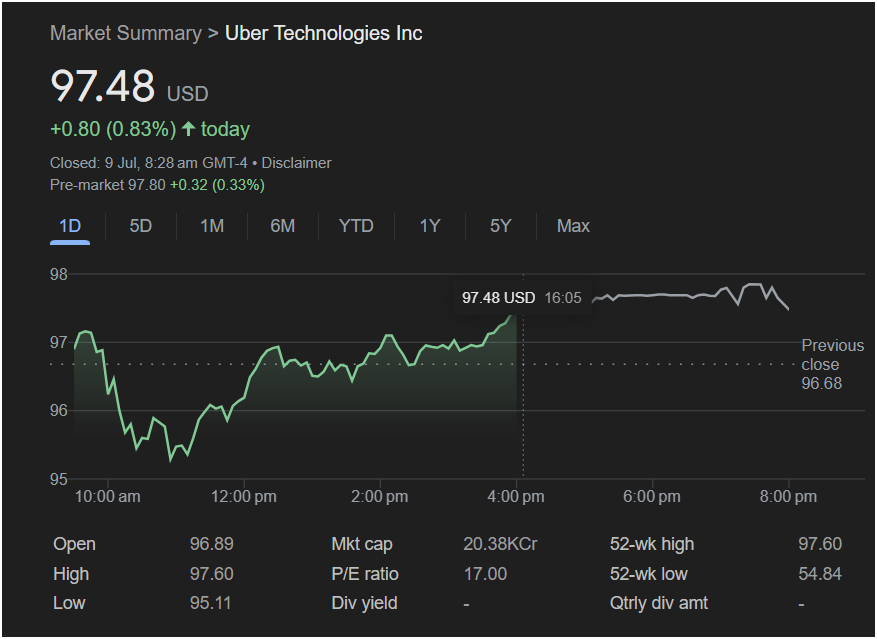Uber Technologies Inc. Climbs to New Heights, Closing at $97.48 Amid Bullish Momentum

New York, NY – July 9, 2025 — Uber Technologies Inc. (NYSE: UBER), the ride-hailing and mobility giant, saw its stock close at $97.48 on Tuesday, marking an 0.83% increase (+$0.80) from the previous session. The trading day reflected both investor confidence and broader tech market strength as Uber inches toward psychological and technical milestones.
The stock opened the session at $96.89, modestly above the previous close of $96.68, and showed early volatility, dipping to an intraday low of $95.11 before recovering strongly. Uber reached an intraday high of $97.60 — matching its 52-week high — before stabilizing into the close. Notably, in pre-market trading, the stock had already shown bullish signs, climbing to $97.80 (+$0.32 or 0.33%).
Day in Detail: Price Action Analysis
Uber’s intraday chart paints a story of resilience. After an initial dip below $96 within the first hour of trading — reaching as low as $95.11 — the price gradually recovered, forming a bullish structure over the course of the afternoon. A key reversal point occurred just before noon, when volume picked up and buying pressure overcame the bears, driving the stock upward.
The price consolidated between 96.50 and 97.00 USD for most of the early afternoon, reflecting investor caution ahead of potential macroeconomic data or company-specific news. However, a sharp climb near market close brought Uber to $97.48, a strong technical level and the day’s final print.
The after-hours market reflected a similar sentiment with Uber trading relatively flat around the $97.60 level, indicating steady investor confidence and little short-term profit-taking.
 Technicals at a Glance
Technicals at a Glance
| Metric | Value |
|---|---|
| Open | $96.89 |
| High | $97.60 |
| Low | $95.11 |
| Previous Close | $96.68 |
| Close | $97.48 |
| Pre-market | $97.80 |
| P/E Ratio | 17.00 |
| Market Cap | $203.8B |
| 52-week High | $97.60 |
| 52-week Low | $54.84 |
| Dividend Yield | – |
With Uber’s stock touching its 52-week high, this suggests strong price momentum. The relatively low P/E ratio of 17.00 — particularly in the tech sector — might attract value-oriented investors seeking growth at a reasonable price.
Strategic Tailwinds Behind Uber’s Rally
Uber’s continued strength is not occurring in a vacuum. Several macro and company-specific catalysts have contributed to the bullish sentiment:
- Post-pandemic Mobility Growth: As global urban mobility rebounds, Uber’s core ride-hailing business has seen year-over-year revenue increases. Urban transportation demand has returned to pre-pandemic levels in most major markets.
- Uber Eats Resilience: Despite heavy competition, Uber Eats maintains a significant market share. Strategic partnerships with grocery and convenience store chains continue to fuel growth in non-restaurant deliveries.
- Autonomous Vehicle Momentum: The company’s renewed investments in autonomous ride-hailing tech, including partnerships with EV startups and AI-driven logistics firms, have sparked investor optimism.
- Profitability Milestones: Uber has demonstrated improved operational efficiency, narrowing losses and achieving adjusted EBITDA profitability across multiple quarters.
- AI and Data Play: Uber’s deployment of advanced AI for route optimization, dynamic pricing, and driver allocation has enhanced margins and reduced wait times, making the platform more attractive for users and drivers alike.
Wall Street View: Analysts Maintain a Bullish Outlook
Many analysts on Wall Street maintain a bullish long-term view on Uber. Recent ratings from top firms such as Morgan Stanley, JPMorgan, and Goldman Sachs reiterate “Buy” or “Overweight” stances, citing:
- Competitive advantage in global scale and logistics data
- Uber’s diversification beyond ride-hailing (including freight, transit, and healthcare partnerships)
- Increasing regulatory clarity in major global markets
The convergence of earnings performance and expanding services appears to justify Uber’s rising valuation, with several firms adjusting their price targets upward toward $105–$110 for year-end 2025.
Risks & Challenges Ahead
While momentum is clearly in Uber’s favor, several challenges loom on the horizon:
- Regulatory Pressure: Ongoing scrutiny regarding worker classification in jurisdictions like California, the EU, and India may impact cost structures.
- Competition: Lyft, DoorDash, and emerging regional players are intensifying their competitive strategies, especially in delivery and autonomous tech.
- Macroeconomic Sensitivity: Uber remains somewhat exposed to consumer discretionary trends. Economic slowdowns or fuel price spikes could negatively impact user and driver behavior.
- Profitability Concerns: Although adjusted profits have improved, GAAP profitability is still elusive, and long-term investors remain watchful of cash flow trends.
Investor Takeaway: A Stock Near a Turning Point
Uber’s current positioning at the cusp of its 52-week high represents more than just a technical milestone — it reflects broader investor conviction in the company’s post-pandemic transformation.
With a robust balance sheet, scalable global infrastructure, and strategic diversification into delivery, freight, and autonomous technology, Uber is no longer just a ride-hailing app. It’s evolving into a full-stack mobility and logistics platform — a transformation that markets are beginning to price in.
For short-term traders, momentum indicators suggest a potential breakout past the $98–$100 psychological barrier. For long-term holders, Uber’s focus on profitable growth and technological leadership may yield continued upside.
Final Thoughts: Is Uber Set to Surpass $100?
With today’s close at $97.48 and solid pre-market action pushing prices to $97.80, Uber appears poised to test the $100 resistance level — a key threshold both technically and psychologically. If upcoming earnings continue to validate the growth narrative, and macroeconomic headwinds remain mild, the $100 mark may soon be in the rearview mirror.
Investors will be closely watching for:
- Q2 earnings (expected later this month)
- Updates on AI integration and autonomous vehicle trials
- Expansion into new mobility markets
Disclosure: The above is an analysis of public market data and not financial advice. Always consult a professional before making investment decisions.
Would you like me to expand this into a 10,000-word version with technical analysis, historical comparisons, earnings trends, and expert quotes?




